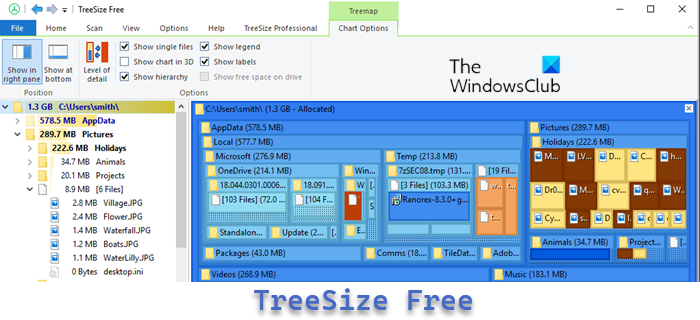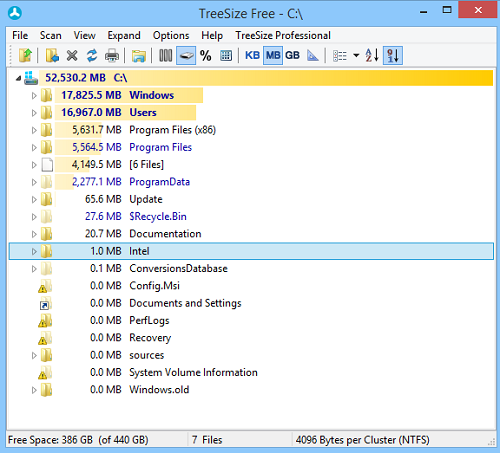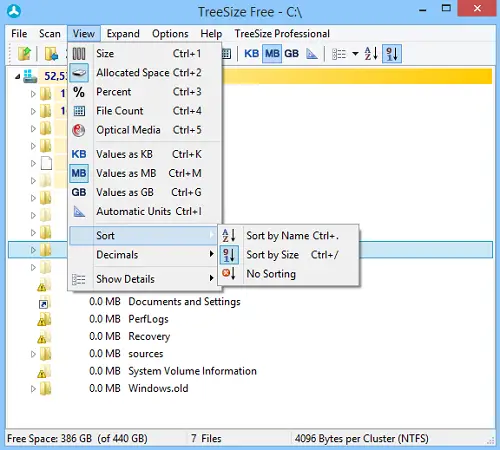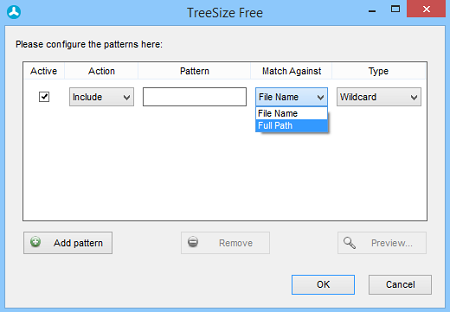Figuring out which directories are most troublesome without reading the drive extensively can be challenging, but TreeSize Free shows you results instantly. The explorer add-on can be launched from the context menu of a folder or a drive and ordered to display the size of folders, subfolders, files, and NTFS compression rates. The software works on both Windows 11 and Windows 10.
TreeSize Free for Windows PC

Scanning is done in a thread, so one can find results already displayed while TreeSize Free is in functioning mode. The space wasted by the file system is made visible, and the results can be printed in a report. The graphical display makes it easier to identify files and folders to be removed or compressed to reduce the size of a package.

Display File & Folder sizes using Context Menu
The column view presents data related to large files and sub-folders in the Windows Explorer-like tree view. The gradient bar in the background visualizes the amount of disk space each folder or subfolder occupies. You can select which columns you want to see and sort them as per your requirements.

The second important item in the list is the “View” menu, where one can find all the tools essential for configuring scan results presentation options. You can select how the results shall be sorted, define the value in which the file and folder sizes be calculated, select the number of decimal places shown in size information, and toggle the columns or tree views.
The third item in the “Options” menu you can configure is the bar’s color. You can also switch it off entirely. Most importantly, you can define how the free program should perform scans and control the display of the information. For instance, NTFS compressed files and folders shall be highlighted or not, or should files be shown in the directory tree.
Find out: What is taking up space on my Hard Drive in Windows?
It is possible to break down the scan results into a certain level of information. TreeSize Free offers a highly-evolved pattern filter, enabling you to define precisely, how the scan results shall be filtered. As shown in the screen-shot below, one can easily add or remove patterns and select how TreeSize should match them.

The latest iteration, like earlier versions, supports the Explorer context menu and drag & drop operations. However, some bug fixes get fixed regularly. So do remember to update it frequently. To do so, select “Help” and run “Check for Update…”, and wait for the popup message. Uncheck the “Check for updates regularly” box.

TreeSize free download
You can download TreeSize Free from its home page.
Can Windows display folder size?
No, it can’t, except that it displays the size of each file. If you want to view the size of the folder, hover your mouse pointer over to the folder, and Windows Explorer will display the size of the folder. You can use third-party tools to add the size column for each folder.
Why does Windows not show the size of folders?
While it can, the Windows team hasn’t included it for some reason. One of them could be to increase the load time, which may take a lot longer than expected. However, when you mouse hover, it does display the size, so all anyone should do is add to the column.
Great app. The PRO version for professional use is also great, with their reports and graphs.